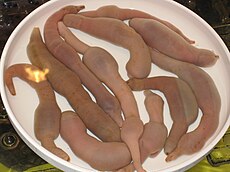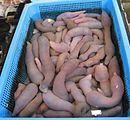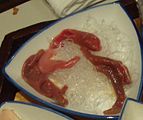Urechis unicinctus
| Urechis unicinctus | |
|---|---|

| |
| Urechis unicinctus at a market in Korea. | |
| Scientific classification | |
| Kingdom: | |
| Phylum: | |
| Class: | |
| Family: | |
| Genus: | |
| Species: | U. unicinctus
|
| Binomial name | |
| Urechis unicinctus von Drasche, 1881[1]
| |
Urechis unicinctus (traditional Chinese: 海腸; simplified Chinese: 海肠; pinyin: hǎicháng; Cantonese Yale: hóichèuhng; Japanese: 螠虫; rōmaji: yumushi; Korean: 개불; romaja: gaebul) is a species of the marine spoon worm. It is widely referred to as the fat innkeeper worm or the penis fish.[2] The body is about 10–30 cm long, cylindrical in shape and yellowish-brown in color. On the surface of the body there are many small papillae. This spoonworm lives in a U-shaped burrow in muddy sand and feeds on detritus. Males and females produce sperm and eggs, respectively.
Habitat
U. unicinctus, like other species of Urechis, lives and burrows in sand and mud. It gets the name "fat innkeeper worm" because the tunnels often contain other animals.
Ecology
This spoonworm is a detritivore and creates a U-shaped burrow in the soft sediment of the seabed. A ring of glands at the front of the proboscis secrete mucus which sticks to the burrow wall. The worm continues to exude mucus as it moves backwards in the burrow thus creating a mucus net. The worm draws water through its burrow by peristaltic contractions of its body and food particles adhere to the net. When enough food is gathered, the worm moves forward in its burrow and swallows the net and entangled food. This process is repeated, and in an area with plenty of detritus, may be completed in only a few minutes.[3]
Uses
In Korea, they are eaten as food,[4] often raw with salt and sesame oil or gochujang. They are distributed in Korea, Japan, and the Pacific coast.
In Chinese cuisine, the worm is stir-fried with vegetables, or dried and powdered to be used as an umami enhancer.
It is also used as fishing bait for fish such as flounder and sea bream.[4]
- Urechis unicinctus
-
Gaebul sold at a fish market at Busan, South Korea.
-
Urechis unicinctus served as hoe in a restaurant in South Korea.
Notes
- ^ van der Land, Jacob; Murina, Galina Vansetti (2012). "Urechis unicinctus (von Drasche, 1881)". WoRMS. World Register of Marine Species. Retrieved 2012-11-12.
{{cite web}}: CS1 maint: multiple names: authors list (link) - ^ เหมียวตะปู (2018-02-04). "'ปลาจู๋' สิ่งมีชีวิตใต้น้ำที่ดันเกิดมามีรูปร่างคล้ายบางอย่าง แถมยังมีน้ำพุ่งออกมาอีกด้วย". catdumb (in Thai). Retrieved 2018-02-08.
- ^ Walls, Jerry G. (1982). Encyclopedia of Marine Invertebrates. TFH Publications. pp. 262–267. ISBN 0-86622-141-7.
External links
- 5 Korean foods for adventurous eaters Chincha.co.uk


